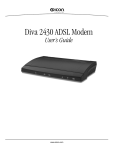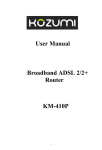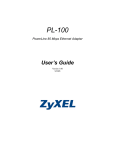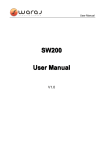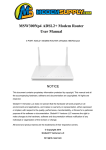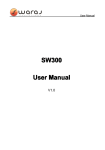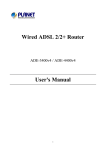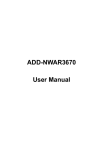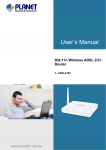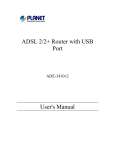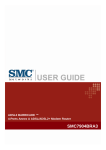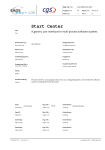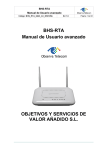Download GWAR3550 User Manual
Transcript
GWAR3550 User Manual GWAR3550 User Manual Contents 1 Introduction ........................................................................................................ 1 1.1 Package List .......................................................................................... 1 1.2 Safety Cautions ..................................................................................... 1 1.3 LEDs and Interfaces .............................................................................. 2 1.4 System Requirements ........................................................................... 4 1.5 Features ................................................................................................ 4 1.6 Supported Protocols .............................................................................. 5 2 Hardware Installation ......................................................................................... 6 3 About the Web Configuration ............................................................................. 9 3.1 3.2 3.3 3.4 3.5 3.6 How to Access the Router ..................................................................... 9 Status................................................................................................... 10 3.2.1 System...................................................................................... 10 3.2.2 LAN........................................................................................... 11 3.2.3 WLAN ....................................................................................... 11 3.2.4 WAN ......................................................................................... 12 3.2.5 Port Mapping ............................................................................ 13 3.2.6 Statistics.................................................................................... 13 3.2.7 ARP Table................................................................................. 15 Wizard ................................................................................................. 15 Network ............................................................................................... 24 3.4.1 LAN........................................................................................... 24 3.4.2 WAN ......................................................................................... 30 3.4.3 WLAN ....................................................................................... 36 Service................................................................................................. 45 3.5.1 DNS .......................................................................................... 45 3.5.2 Firewall ..................................................................................... 48 3.5.3 UPNP........................................................................................ 54 3.5.4 IGMP Proxy .............................................................................. 55 3.5.5 TR069 ....................................................................................... 56 3.5.6 ACL........................................................................................... 58 Advance............................................................................................... 59 3.6.1 Bridge Setting ........................................................................... 59 3.6.2 Routing ..................................................................................... 60 i GWAR3550 User Manual 3.7 3.8 3.6.3 Port Mapping ............................................................................ 63 3.6.4 QoS........................................................................................... 65 3.6.5 SNMP ....................................................................................... 67 3.6.6 Others ....................................................................................... 68 Admin .................................................................................................. 68 3.7.1 Commit/Reboot......................................................................... 68 3.7.2 Upgrade .................................................................................... 69 3.7.3 System Log............................................................................... 70 3.7.4 Password .................................................................................. 71 3.7.5 Time Zone................................................................................. 72 Diagnostic............................................................................................ 73 3.8.1 Ping........................................................................................... 73 3.8.2 ATM Loopback.......................................................................... 74 3.8.3 ADSL ........................................................................................ 74 3.8.4 Diagnostic Test ......................................................................... 75 ii GWAR3550 User Manual 1 Introduction The ADSL Router supports multiple line modes. It provides four 10/100 base-T Ethernet interfaces at the user end. The device provides high-speed ADSL broadband connection to the Internet or Intranet for high-end users, such as net bars and office users. The device provides high performance access to the Internet, downlink up to 24 Mbps and uplink up to 1 Mbps. The device supports WLAN access, as WLAN AP or WLAN router, to the Internet. It complies with IEEE 802.11, 802.11b/g specifications, and WEP, WPA and WPA2 security specifications. 1.1 Package List 1 x ADSL Router 1 x external splitter 1 x power adapter 2 x telephone cables (RJ11) 1 x Ethernet cable (RJ45) 1 x CD 1 x Quick Installation Guide 1.2 Safety Cautions Follow the following instructions to prevent the device from risks and damage caused by fire or electric power: Use volume labels to mark the type of power. Use the power adapter packed within the device package. Pay attention to the power load of the outlet or prolonged lines. An overburden power outlet or damaged lines and plugs may cause electric shock or fire accident. Check the power cords regularly. If you find any damage, replace it at once. Proper space left for heat dissipation is necessary to avoid damage caused by overheating to the device. The long and thin holes on the device are 1 GWAR3550 User Manual designed for heat dissipation to ensure that the device works normally. Do not cover these heat dissipation holes. Do not put this device close to a place where a heat source exits or high temperature occurs. Avoid the device from direct sunshine. Do not put this device close to a place where it is over damp or watery. Do not spill any fluid on this device. Do not connect this device to any PCs or electronic products, unless our customer engineer or your broadband provider instructs you to do this, because any wrong connection may cause power or fire risk. Do not place this device on an unstable surface or support. 1.3 LEDs and Interfaces Front Panel The following table describes the LEDs of the device: LEDs Color Green Power Red Status Description On The device is powered on. Off The device is powered off. The device is self-testing or self-testing On is failed, or the software is upgrading. The device has established connection On ADSL Green with the office physical layer. Blinks The device is handshaking with the (fast) office physical layer. Blinks The device does not detect the signals. (slow) The device has a successful Internet Internet Green On connection in the routing mode, and no data is being transmitted. 2 GWAR3550 User Manual LEDs Color Status Description Data is being transmitted on the Blinks Internet in the routing mode. Off The device is in bridge mode. After the successful synchronous in Red On the routing mode, the Internet connection is failed. The On LAN1/LAN2/ LAN3/LAN4 Green device has successful LAN connection. Data is being transmitted on LAN or Blinks data is being transmitted on the Internet in the bridge mode. Off The LAN connection is failed. The device has successful WLAN On WLAN Green connection. Blinks Data is being transmitted on WLAN. Off The WLAN connection is failed. Off WPS Green WPS is disabled. WPS is enabled, and is waiting for Blinks client to negotiate. Rear Panel The following table describes the interfaces of the device: Interface Description Wireless antenna. Line RJ-11 interface, for connecting to the ADSL interface or a splitter through the telephone cable. 3 GWAR3550 User Manual Interface Description LAN1/LAN2/ RJ-45 interface, for connecting to the Ethernet interface of LAN3/LAN4 Power the PC or the Ethenet devices with the cable. Power interface, for connecting to the power adapter of 12 V DC, 800 mA. Reset to the factory defaults. To restore factory defaults, keep Reset the device powered on and push a paper clip into the hole. Press down the button over 3 seconds and then release. WPS On/Off Press the button and hold for more than 3 seconds, to initialize WPS negotiation. Power switch, power on or power off the router. 1.4 System Requirements Recommended system requirements are as follows: A 10/100 base-T Ethernet card is installed on your PC A hub or Switch. (attached to several PCs through one of Ethernet interfaces on the device) Operating system: Windows 98SE, Windows 2000, Windows ME, Windows XP or Windows Vista Internet Explorer V5.0 or higher, Netscape V4.0 or higher, or firefox 1.5 or higher 1.5 Features The device supports the following features: Various line modes (line auto-negotiation) External PPPoE dial-up access Internal PPPoE/PPPoA dial-up access Zero installation PPP bridge mode (ZIPB) 1483B/1483R/MER access Multiple PVCs (eight at most) A single PVC with multiple sessions Multiple PVCs with multiple sessions DHCP server 4 GWAR3550 User Manual NAT/NAPT Static route Firmware upgrading through Web, TFTP, or FTP Rsetting to the factory defaults through Reset button or Web DNS relay Virtual server Web interface Telnet CLI System status display PPP session PAP/CHAP IP/Port, MAC, URL filter Remote access control Line connection status test Remote access control Backup and restoration of configuration file IP quality of service (QoS) Universal plug and play (UPnP) WLAN with high-speed data transmission rate, up to 54 Mbps, compatible with IEEE 802.11b/g, 2.4 GHz compliant equipment 1.6 Supported Protocols The device supports the following protocols: ITU G.992.1 (G.DMT) Annex A ITU G.992.2 (G.LITE) ANSI T1.413 Issue 2 ITU G.992.3 (ADSL2) ITU G.992.5 (ADSL2+) Annex L Annex M 5 GWAR3550 User Manual 2 Hardware Installation Step 1 Connect the Line interface of the device and the Modem interface of the splitter through a telephone cable. Connect the phone to the Phone interface of the splitter through a cable. Connect the incoming line to the Line interface of the splitter. The splitter has three interfaces: Line: Connect to a wall phone jack (RJ-11 jack) Modem: Connect to the ADSL jack of the device Phone: Connect to a telephone set. Step 2 Connect the LAN interface of the device to the network card of the PC through an Ethernet cable (MDI/MDIX). I Note: Use twisted-pair cables to connect with the hub or switch. Step 3 Plug one end of the power adapter to the wall outlet and connect the other end to the Power interface of the device. Connection 1 The following figure displays the application diagram for the connection of the router, PC, splitter and the telephone sets, when no telephone set is placed before the splitter. 6 GWAR3550 User Manual Figure 1 Connection diagram (Without connecting telephone sets before the splitter) Connection 2 Figure 2 shows the connection when the splitter is installed close to the router. Figure 2 Connection diagram (Connecting a telephone set before the splitter) Note: When connection 2 is used, the filter must be installed close to the telephone cable. See Figure2. Do not use the splitter to replace the filter. Installing a telephone directly before the splitter may lead to failure of connection between the device and the central office, or failure of Internet access, or slow connection speed. If you really need to add a telephone set before the splitter, 7 GWAR3550 User Manual you must add a microfilter before a telephone set. Do not connect several telephones before the splitter or connect several telephones with the microfilter. 8 GWAR3550 User Manual 3 About the Web Configuration This chapter describes how to configure the router by using the Web-based configuration utility. 3.1 How to Access the Router The following is the detailed description of accesing the router for the first time. Step 1 Open the Internet Explorer (IE) browser and enter http://192.168.1.1. Step 2 In the LOGIN page that is displayed, enter the username and password. The username and password of the super user are admin and admin respectively. The user name and password of the common user are user and user respectively. If you log in as the super user, the page shown in the following figure appears. You can check, configure and modify all the settings. 9 GWAR3550 User Manual If you log in as a common user, you can check the status of the router, but can not configure the most of the settings. 3.2 Status In the navigation bar, choose Status. In the Status page that is displayed contains: System, LAN, WLAN, WAN, Port Mapping, Statistic, and ARP Table. 3.2.1 System Choose Status > System. The page that is displayed shows the current status and some basic settings of the router, such as software version, DSP version, uptime, upstream speed, and downstream speed. 10 GWAR3550 User Manual 3.2.2 LAN Choose Status > LAN. The page that is displayed shows some basic LAN settings of the router. In this page, you can view the LAN IP address, DHCP server status, MAC address, and DHCP client table. If you want to configure the LAN network, refer to chapter 3.4.1.1 LAN IP. 3.2.3 WLAN Choose Status > WLAN. The page that is displayed shows some basic WLAN settings of the router. In this page, you can view basic status of WAN and DNS server. If you want to configure the WAN network, refer to chapter 3.4.3 . 11 GWAR3550 User Manual 3.2.4 WAN Choose Status > WAN. The page that is displayed shows some basic WAN settings of the router. In this page, you can view basic status of WAN and DNS server. If you want to configure the WAN network, refer to chapter 3.4.2.1 WAN. 12 GWAR3550 User Manual 3.2.5 Port Mapping Choose Status > Port Mapping. In this page, you can view the mapping relation and the status of port mapping. 3.2.6 Statistics Choose Status > Statistics. The Statistics page that is displayed contains Traffic Statistic and DSL Statistic. 3.2.6.1 Traffic Statistic Click Traffic Statistic in the left pane. The page shown in the following figure appears. In this page, you can view the statistics of each network port. 13 GWAR3550 User Manual 3.2.6.2 DSL Statistic Click DSL Statistic in the left pane. The page shown in the following figure appears. In this page, you can view the ADSL line status, upstream rate, downstream rate, and other information. 14 GWAR3550 User Manual 3.2.7 ARP Table Choose Status > ARP Table. In the ARP Table page, you can view the table that shows a list of learned MAC addresses. 3.3 Wizard When subscribing to a broadband service, you should be aware of the method by which you are connected to the Internet. Your physical WAN device can be either PPP, ADSL, or both. The technical information about the properties of your Internet connection is provided by your Internet Service Provider (ISP). For example, your ISP should inform you whether you are connected to the Internet using a static or dynamic IP address, and the protocol that you use to communicate on the Internet. In the navigation bar, choose Wizard. The page shown in the following figure appears. The Wizard page guides fast and accurate configuration of the Internet connection and other important parameters. The following sections describe these various configuration parameters. Whether you configure these parameters or use the default ones, click NEXT to enable your Internet connection. 15 GWAR3550 User Manual Enter the correct password and then click NEXT. The page shown in the following figure appears. In this page, you can set the system time and Network Time Protocol (NTP) server. The following table describes the parameters of this page: Description Field You can disable or enable NTP function. You have to State enable it if you want to configure the parameters in this page. 16 GWAR3550 User Manual Description Field Server IP Enter the IP address of the specified time server manually. Set the interval that the router obtains the time from the Interval time server. That is, the interval that the router verifies the time with the server. Time Zone Choose the time zone of your country. GMT time It displays the Greenwich mean time. After finishing the configuration, click NEXT. The page shown in the following figure appears. The following table describes the parameters of this page: Description Field The virtual path between two points in an ATM PVC Settings network, and its valid value is from 0 to 255. The virtual channel between two points in an ATM network, ranging from 32 to 65535 (0 to 31 is 17 GWAR3550 User Manual Description Field reserved for local management of ATM traffic). Encapsulation Select the method of encapsulation provided by your ISP. You can select LLC/SNAP or VC-Mux. Select the WAN connection type. You can select 1483 Channel Mode Bridged, 1483 MER, PPP over Ethernet (PPPoE), PPP over ATM (PPPoA), or 1483 Routed. The username and password apply to PPPoE and PPP Settings PPPoA encapsulation only. Ensure that you enter the correct username and password. Default Route You can select Enable or Disable. Obtain DNS Automatically: Obtain the DNS server assigned by the uplink equipment, such as DNS Settings BAS. Use the following DNS server address: If you want to enter the DNS server address by yourself, select it and enter the related data. After finishing the configuration, click NEXT. The page shown in the following figure appears. 18 GWAR3550 User Manual The following table describes the parameters of this page: Description Field You can choose Enable or Disable. By default, WAN WLAN interface is enabled. Interface You need to enable WAN interface, and then you can set the parameters in this page. Choose the working mode of the router. You can choose Band 2.4 GHz (B), 2.4 GHz (G), or 2.4 GHz (B + G). By defaut, the band is 2.4 GHz (B + G). The service set identification (SSID) is a unique name to identify the router in the wireless LAN. Wireless stations SSID associating to the router must have the same SSID. Enter a descriptive name that is used when the wireless client connecting to the router. Configure the wireless encryption mode. You can choose None, WEP, WPA (TKIP), WPA (AES), WPA2 (AES), WPA2 (TKIP), or WPA2 Mixed. Wired equivalent privacy (WEP) encrypts data frames before transmitting over the wireless network. Encryption Wi-Fi protected access (WPA) is a subset of the IEEE802.11i security specification draft. WPA2 Mixed is the collection of WPA and WPA2 encryption modes. The wireless client establishes the connection between the router through WPA or WPA2. Key differences between WPA and WEP are user authentication and improved data encryption. After finishing the configuration, click NEXT. The page shown in the following figure appears. 19 GWAR3550 User Manual 1483 Bridged In the Setup WAN Interface page, set the channel mode to 1483 Bridged 20 GWAR3550 User Manual 1483 MER In the Setup WAN Interface page, set the channel mode to 1483 MER 21 GWAR3550 User Manual PPPoE In the Setup WAN Interface page, set the channel mode to PPPoE 22 GWAR3550 User Manual PPPoA In the Setup WAN Interface page, set the channel mode to PPPoA 23 GWAR3550 User Manual 1483 Routed In the Setup WAN Interface page, set the channel mode to 1483 Routed 3.4 Network In the navigation bar, choose Network. The Network page that is displayed contains LAN, WAN, and WLAN. 3.4.1 LAN Choose Network > LAN. The LAN page that is displayed contains LAN IP, DHCP, and DHCP Static IP. 24 GWAR3550 User Manual 3.4.1.1 LAN IP Click LAN IP in the left pane. The page shown in the following figure appears. In this page, you can change IP address of the router. The default IP address is 192.168.1.1. This is the private IP address of the router. This is the address under which the router can be reached in the local network. It can be freely assigned from the block of available addresses. The following table describes the parameters and button of this page: Field Description Enter the IP of LAN interface. It is recommended to IP Address use an address from a block that is reserved for private use. This address block is 192.168.1.1192.168.255.254. Enter the subnet mask of LAN interface. The range Subnet Mask of subnet mask is from 255.255.0.0-255.255.255.254. Secondary IP Select it to enable the secondary LAN IP. The two LAN IP addresses must be in the different network. IGMP Snooping You can disable or enable IGMP Snooping. Apply Changes Click it to save the settings of this page. 25 GWAR3550 User Manual 3.4.1.2 DHCP Dynamic Host Configuration Protocol (DHCP) allows the individual PC to obain the TCP/IP configuration from the centralized DHCP server. You can configure this router as a DHCP server or disable it. The DHCP server can assign IP address, IP default gateway, and DNS server to DHCP clients. This router can also act as a surrogate DHCP server (DHCP proxy) where it relays IP address assignment from an actual real DHCP server to clients. You can enable or disable DHCP server or DHCP proxy. Click DHCP in the left pane. The page shown in the following figure appears. The following table describes the parameters in this page: Field Description If set to DHCP Server, the router can assign IP DHCP Mode addresses, IP default gateway and DNS Servers to Windows95, Windows NT and other systems that support the DHCP client. IP Pool Range Show Client It specifies the first and the last of contiguous IP address of the IP address pool. Click it, the Active DHCP Client Table page appears. It shows the assigned IP address of the clients. 26 GWAR3550 User Manual Field Default Description Enter the IP default gateway of the IP address pool. Gateway Max Lease Time The lease time determines the period that the PCs retain the assigned IP addresses before the IP addresses change. Enter the domain name if you know. If you leave this blank, the domain name obtained by DHCP from the Domain Name ISP is used. You must enter host name (system name) on each individual PC. The domain name can be assigned from the router through the DHCP server. Set Click it, the Device IP Range Table page appears. You VendorClass IP can configure the IP address range based on device Range type. Click Show Client in the DHCP Settings page. The page shown in the following figure appears. You can view the IP address assigned to each DHCP client. The following table describes the parameters and buttons in this page: Field IP Address Description It displays the IP address relative to the MAC address. It displays the MAC address of the PC. Each Ethernet device has a unique MAC address. MAC Address The MAC address is assigned at the factory and it consists of six pairs of hexadecimal character, for example, 00-A0-C5-00-02-12. 27 GWAR3550 User Manual Field Description It displays the lease time. The lease time determines Expired (s) the period that the PCs retain the assigned IP addresses before the IP addresses change. Refresh Click it to refresh this page. Close Click it to close this page. Click Set VendorClass IP Range in the DHCP Settings page. The page shown in the following figure appears. You can configure the IP address range based on device type. Choose None in the DHCP Settings page. The page shown in the following figure appears. 28 GWAR3550 User Manual Choose DHCP Relay in the DHCP Mode page. The page shown in the following figure appears. The following table describes the parameters of this page: Field Description If set to DHCP Relay, the router acts a surrogate DHCP DHCP Mode Server and relays the DHCP requests and reponses Relay Server Enter the DHCP server address provided by your ISP. between the remote server and the client. 29 GWAR3550 User Manual 3.4.1.3 DHCP Static IP Click DHCP Static IP in the left pane. The page shown in the following figure appears. You can assign the IP addresses on the LAN to the specific individual PCs based on their MAC address. The following table describes the parameters and buttons of this page: Field Description IP Address It specifies the IP address of the IP address pool. Mac Address Enter the MAC address of a PC on the LAN. Add After entering the IP address and MAC address, click it. A row will be added in the DHCP Static IP Table. Delete Selected Select a row in the DHCP Static IP Table, then click it, this row is deleted. Undo Click it to refresh this page. DHCP Static IP Table It shows the assigned IP address based on the MAC address. 3.4.2 WAN Choose Network > WAN. The WAN page that is displayed contains WAN, ATM Setting, and ADSL Setting. 3.4.2.1 WAN Click WAN in the left pane. The page shown in the following figure appears. 30 GWAR3550 User Manual In this page, you can configure WAN interface of your router. The following table describes the parameters of this page: Field Default Route Selection VPI Description You can choose Auto or Specified. The virtual path between two points in an ATM network, ranging from 0 to 255. The virtual channel between two points in an VCI ATM network, ranging from 32 to 65535 (1 to 31 are reserved for known protocols) Encapsulation Channel Mode Enable NAPT You can choose LLC and VC-Mux. You can choose 1483 Bridged, 1483 MER, PPPoE, PPPoA, or 1483 Routed. Select it to enable the NAPT function of the router. If you do not select it and you want to 31 GWAR3550 User Manual Field Description access the Internet normally, you must add a route on the uplink equipment. Otherwise, the access to the Internet fails. Normally, it is required to enable NAPT. Enabel IGMP You can enable or disable IGMP function. PPP Settings User Name Password Type The correct user name that your ISP has provided to you. The correct password that your ISP has provided to you. You can choose Continuous, Connect on Demand, or Manual. If select connect on demand, you need to enter the idle timeout time. Within the preset Idle Time (min) minutes, if the router does not detect the flow of the user automatically continuously, disconnects the the router PPPoE connection. WAN IP Settings You can choose Fixed IP or DHCP. If select fixed IP, you should enter the local IP Type address, remote IP address and subnet mask. If set to use DHCP, the router is a DHCP client, the WAN IP address is assigned by the remote DHCP server. Local IP Address Remote IP Address Netmask Unnumbered Add It is the IP address of WAN interface that is provided by your ISP. This is the gateway IP address that is provided by your ISP. It is the subnet mask of the local IP address. Select this checkbox to enable IP Unnumbered function. After configuring the parameters of this page, click it to add a new PVC into the current ATM 32 GWAR3550 User Manual Field Description VC table. Select a PVC in the current ATM VC table, then modify the parameters of this PVC. After Modify finishing, click it to apply the change of this PVC. This table shows the existed PVCs. It shows the Interface name, channel mode, VPI/VCI, Current ATM VC Table encapsulation mode, local IP address, remote IP address and other information. The maximum item of this table is eight. Click it, the PPP Interface-Modify page appears. You can modify the PVCs’ parameters. Click in the PPPoE mode. The page shown in the following figure appears. In this page, you can configure parameters of this PPPoE PVC. 33 GWAR3550 User Manual The following table describes the parameters and buttons of this page: Field Protocol Description The protocol type used for this WAN connection. ATM VCC The ATM virtual circuit connection assigned for this PPP interface (VPI/VCI). Login Name The login name provided by your ISP. Password The password provided by your ISP. Authentication Method You can choose AUTO, CHAP, or PAP. Connection Type You can choose Continuous, Connect on Demand, or Manual. Idle Time (s) If choose Connect on Demand, you need to enter the idle timeout time. Within the preset minutes, if the router does not detect the flow of the user continuously, the router automatically disconnects the PPPoE connection. Bridge You can choose Bridged Ethernet, Bridged PPPoE, or Disable Bridge. AC-Name The accessed equipment type. Service-Name The service name. Apply Changes Click it to save the settings of this page. Return Click it to return to the WAN Interface page. Undo Click it to refresh this page. 3.4.2.2 ATM Setting Click ATM Setting in the left pane. The page shown in the following figure appears. In this page, you can configure the parameters of the ATM, including QoS, PCR, CDVT, SCR, and MBS 34 GWAR3550 User Manual The following table describes the parameters and buttons of this page: Field Description VPI The virtual path identifier of the ATM PVC. VCI The virtual channel identifier of the ATM PVC. QoS The QoS category of the PVC. You can choose UBR, CBR, rt-VBR, or nrt-VBR. PCR The maximum rate at which cells can be transported along a connection in the ATM network. CDVT The amount of delay permitted between ATM cells (expressed in microseconds). SCR The maximum rate that traffic can pass over a PVC without the risk of cell loss. MBS The maximum number of cells that can be transmitted at the PCR. Apply Changes Click it to save the settings of this page. Undo Click it to refresh this page. 3.4.2.3 ADSL Setting Click ADSL Setting in the left pane. The page shown in the following figure appears. 35 GWAR3550 User Manual In this pae, you can select the DSL modulation. Mostly, you need to remain this factory default settings. The router supports these modulations: G.lite, G.Dmt, T1.413, ADSL2, ADSL2+, AnnexL, and AnnexM. The router negotiates the modulation modes with the DSLAM. 3.4.3 WLAN Choose Network > WLAN. In the WLAN page that is displayed contains Basic Setting, Security, Access Control, multi-SSID, Advance Setting, and WPS. 3.4.3.1 Basic Setting Click Basic Setting in the left pane. The page shown in the following figure appears. In this page, you can configure the parameters for wireless LAN clients that may connect to the router. 36 GWAR3550 User Manual The following table describes the parameters and buttons of this page: Field Description Choose the working mode of the router. You can Band choose 2.4 GHz (B), 2.4 GHz (G), or 2.4 GHz (B + G). By defaut, the band is 2.4 GHz (B + G). Choose the network modle of the router, which is Mode varied according to the software. By defaut, the network model of the router is AP. The service set identification (SSID) is a unique name to identify the router in the wireless LAN. SSID Wireless stations associating to the router must have the same SSID. Enter a descriptive name that is used when the wireless client connecting to the router. A channel is the radio frequency used by 802.11b/g wireless devices. There are 13 Channel Number channels (from 1 to 13) available depending on the geographical area. You may have a choice of channels (for your region) and you should use a different channel from an adjacent AP to reduce 37 GWAR3550 User Manual Field Description the interference. Interference and degrading performance occurs when radio signal from different APs overlap. Choose a channel from the drop-down list box. Radio Power (Percent) Show Active Clients Apply Changes 3.4.3.2 You can choose the transmission power of the radio signal. It is recommended to choose the default value 100%. Click it to view the information of the wireless clients that are connected to the router. Click it to save the settings of this page. Security Click Security in the left pane. The page shown in the following figure appears. The following table describes the parameters of this page: Field Encryption Description Configure the wireless encryption mode. You can choose None, WEP, WPA (TKIP), WPA (AES), 38 GWAR3550 User Manual Field Description WPA2 (AES), WPA2 (TKIP), or WPA2 Mixed. Wired equivalent privacy (WEP) encrypts data frames before transmitting over the wireless network. Wi-Fi protected access (WPA) is a subset of the IEEE802.11i security specification draft. WPA2 Mixed is the collection of WPA and WPA2 encryption modes. The wireless client establishes the connection between the router through WPA or WPA2. Key differences between WPA and WEP are user authentication and improved data encryption. It is available when you set the encryption mode Set WEP Key to WEP. Click it, the Wireless WEP Key Setup page appears. Select Personal (Pre-Shared Key), enter the pre-shared key in the Pre-Shared Key field. Select Enterprise (RADIUS), enter the port, IP address, and password of the Radius WPA Authentication server. You need to enter the username and Mode password provided by the Radius server when the wireless client connects the router. If the encrypton is set to WEP, the router uses 802.1 X authentication, which is Radius authentication. Click Set WEP Key, and the following page appears. 39 GWAR3550 User Manual The following describes the parameters and button of this page: Field Key Length Description Choose the WEP key lenth. You can Choose 64-bit or 128-bit. If you choose 64-bit, you can choose ASCII (5 Key Format characters) or Hex (10 characters). If you choose 128-bit, you can choose ASCII (13 characters) or Hex (26 characters). Default Tx Key Choose the index of WEP Key. You can choose Key 1, Key 2, Key 3, or Key 4. The Encryption keys are used to encrypt the data. Both the router and wireless stations must use the Encryption Key 1 to 4 same encryption key for data transmission. If you choose 64-bit and ASCII (5 characters), enter any 5 ASCII characters. If you choose 64-bit and Hex (10 characters), enter any 10 hexadecimal characters. 40 GWAR3550 User Manual Field Description If you choose 128-bit and ASCII (13 characters), enter any 13 ASCII characters. If you choose 128-bit and Hex (26 characters), enter any 26 hexadecimal characters. Apply Changes 3.4.3.3 Click it to save the settings of this page. Access Control Click Advanced Setting in the left pane. The page shown in the following figure appears. In this page, you can configure the access control of the wireless clients. Choose Allow Listed in the Wireless Access Control Mode field to enable white list function. Only the devices whose MAC addresses are listed in the Current Access Control List can access the router. Choose Deny Listed in the Wireless Access Control Mode field to enable black list function. The devices whose MAC addresses are listed in the Current Access Control List are denied to access the router. 41 GWAR3550 User Manual 3.4.3.4 multi-SSID Click multi-SSID in the left pane. The page shown in the following figure appears. The following table describes parameterand button of this page: Field SSID Description The service set identification (SSID) is a unique name to identify the router in the wireless LAN. Apply Changes Click it to save the settings of this page. 42 GWAR3550 User Manual 3.4.3.5 Advance Setting Click Advance Setting in the left pane. The page shown in the following figure appears. In this page, you can configure the wireless advanced parameters. It is recommended to use the default parameters. Note: The parameters in the Wireless Advanced Settings page are modified by the professional personnel, it is recommended to keep the default values. The following table describes the parameters and button of this page: Field Description Select the router operating in the open system or encryption authentication. You can choose Open Authentication System, Shared Key, or Auto. In the open system, the wireless client can directly connect to the device In the encryption authentication, the wireless 43 GWAR3550 User Manual Field Description client connects to the router through the shared key. Choose the transmission rate of the wireless data. Data Rate You can choose Auto, 1 M, 2 M, 5.5 M, 11 M, 6 M, 9 M, 12 M, 18 M, 24 M, 36 M, 48 M, or 54 M. Select whether the router broadcasts SSID or not. You can select Enable or Disable. Broadcast SSID Select Enable, the wireless client searchs the router through broadcasting SSID. Select Disable to hide SSID, the wireless clients can not search the SSID. Wireless isolation. Select Enable, the wireless Relay Blocking clients that are connected to the router can not intercommunication. Ethernet to Wheteher the wireless network can communicate Wireless Blocking with the Ethernent network or not. Apply Changes Click it to save the settings of this page. 3.4.3.6 WPS Click WPS in the left pane. The page shown in the following figure appears. 44 GWAR3550 User Manual WPS Authentication: The WPS service is enabled by default. There are there methods used in the Wi-Fi Protected Setup. In order to use wps authentication, you can select one method from the following there methods. Press the WPS button on the rear panel for more than 3 seconds. The router generates PIN, see the above figure. Click Regenerate PIN to generate a new PIN, then click Start PCB, press WPS button on the wireless client simultaneously. The wireless client automatically establishes the connection with the router through the encryption mode, and you need not to enter the key. The wireless client generates PIN. In the above figure, enter PIN of the wireless client in the Client PIN Number field, then click Start PIN to establish the connection. Note: The wireless client establishes the connection with the router through WPS negotiation.The wireless client must support WPS. 3.5 Service In the navigation bar, choose Service. The Service page that is displayed contains DNS, Firewall, UPNP, IGMP Proxy, TR069, and ACL. 3.5.1 DNS Choose Service > DNS. The DNS page that is displayed contains DNS and DDNS. 3.5.1.1 DNS Click DNS in the left pane. The page shown in the following figure appears. Domain name system (DNS) is an Internet service that translates the domain name into IP address. Because the domain name is alphabetic, it is easier to remember. The Internet, however, is based on IP addresses. Every time you use a domain name, a DNS service translates the name into the corresponding IP address. For example, the domain name www.example.com might translate to 198.105.232.4. The DNS system has its own network. If one DNS server does 45 GWAR3550 User Manual not know how to translate a particular domain name, it asks another one, and so on, until the correct IP address is returned. The following table describes the parameters and buttons of this page: Field Attain DNS Automatically Description Select it, the router accepts the first received DNS assignment from one of the PPPoA, PPPoE or MER enabled PVC(s) during the connection establishment. Set DNS Select it, enter the primary and optional secondary Manually DNS server IP addresses. Apply Changes Click it to save the settings of this page. Reset Selected Click it to refresh this page. 3.5.1.2 DDNS Click DDNS in the left pane. The page shown in the following figure appears. 46 GWAR3550 User Manual The following table describes the parameters of this page: Field Description DDNS provider Choose the DDNS provider name. Hostname The DDNS identifier. Interface The WAN interface of the router. Enable Enable or disable DDNS function. Username The name provided by DDNS provider. Password The password provided by DDNS provider. Email The email provided by DDNS provider. Key The key provided by DDNS provider. 47 GWAR3550 User Manual 3.5.2 Firewall Choose Service > Firewall. The Firewall page that is displayed contains IPPort Fileter, MAC Filter, URL Blocking, Virtual Server, DMZ Setting, ALG Setting, and DoS Setting. 3.5.2.1 IPPort Filter Click IPPort Filter in the left pane. The page shown in the following figure appears. Entries in this table are used to restrict certain types of data packets through the gateway. These filters are helpful in securing or restricting your local network. Click Apply Changes to save the settings of this page. Click Add to add a new rule of the IP/Port filter. 3.5.2.2 MAC Filter Click MAC Filter in the left pane. The page shown in the following figure appears. Entries in this table are used to restrict certain types of data packets from your 48 GWAR3550 User Manual local network to Internet through the gateway. These filters are helpful in securing or restricting your local network. Click Apply Changes to save the settings of this page. Click Add to add a new rule of the MAC filter. 3.5.2.3 URL Blocking Click URL Blocking in the left pane. The page shown in the following figure appears. This page is used to block a fully qualified domain name (FQDN), such as tw.yahoo.comand and filtered keyword. You can add or delete FQDN and filtered keyword. 49 GWAR3550 User Manual The following table describes the parameters and buttons of this page: Field URL Blocking Description You can choose Disable or Enable. Capability Choose Disabled to turn off URL blocking and keyword filtering. Choose Enable to block access to the URLs and keywords specified in the URL Blocking Table and Keyword Filtering Table. Apply Changes Click it to save the settings of this page. Keyword The keyword to block. Add Keyword Click it to add the keyword to the keyword filtering table. Delete Selected Select a row in the Keyword Filtering Table and click it Keyword to delete the row. URL Blocking A list of the URL (s) to which access is blocked. Table 3.5.2.4 Virtual Server Click Virtual Server in the left pane. The page shown in the following figure appears. 50 GWAR3550 User Manual The following table describes the parameters of this page: Field Description You can choose the common service type, such as AUTH, DNS, or FTP. You can also define a service name. If you choose the common service type, the Service Type corresponding WAN communication port/service host communication port has the default settings. If you define service type, you need to enter the corresponding port. Protocol Choose the transport layer protocol that the service type uses. You can choose TCP or UDP. WAN Setting You can choose Interface or Ip Address. WAN Interface Choose the router port that uses virtual server. WAN Port Enter the access port on the WAN. LAN Open Port Enter the port number of the specified service type. LAN Ip Address Enter the IP address of the virtual server. It is in the 51 GWAR3550 User Manual Field Description same network segment with LAN IP address of the router. 3.5.2.5 DMZ Setting Click DMZ Setting in the left pane. The page shown in the following figure appears. A demilitarized zone is used to provide Internet services without sacrificing unauthorized access to its local private network. Typically, the DMZ host contains services accessible to Internet traffic, such as web (HTTP) servers, FTP servers, SMTP (e-mail) servers and DNS servers. Step 1 Select Enable DMZ to enable this function. Step 2 Enter an IP address of the DMZ host. Step 3 Click Apply Changes to save the settings of this page. 3.5.2.6 ALG Setting Click ALG Setting in the left pane. The page shown in the following figure appears. 52 GWAR3550 User Manual 3.5.2.7 DoS Setting Click DoS Setting in the left pane. The page shown in the following figure appears. Denial-of-service attack (DoS Attack) is a type of attack on a network that is designed to bring the network to its knees by flooding it with useless traffic. In this page, you can prevent DoS attacks. 53 GWAR3550 User Manual 3.5.3 UPNP Choose Service > UPNP. The page shown in the following figure appears. This page is used to configure UPnP. The system acts as a daemon after you enable it. 54 GWAR3550 User Manual 3.5.4 IGMP Proxy Choose Service > IGMP Proxy in the left pane. The page shown in the following figure appears. IGMP proxy enables the system to issue IGMP host messages on behalf of hosts that the system discovered through standard IGMP interfaces. The system acts as a proxy for its hosts after you enable it. 55 GWAR3550 User Manual 3.5.5 TR069 Choose Service > TR069. The page shown in the following page appears. In this page, you can configure the TR-069 of the router. 56 GWAR3550 User Manual The following table describes the parameters and buttons of this page. Field Description ACS URL The URL of the auto-configuration server to connect to. User Name The user name for logging in to the ACS. Password The password for logging in to the ACS. Periodic Inform Enable Select Enable to periodically connect to the ACS to check for configuration updates. Periodic Inform Interval Specify the amount of time between connections to ACS. Connection Request User Name The username to connect the router from Password The password to connect the router from the ACS. the ACS. Debug ACS Certificates CPE Specify whether to check the ACS certification of the router. Show Message Select Enable to display ACS SOAP messages on the serial console. CPE Sends GetRPC Select Enbale, the CPE contact the ACS to obtain configuration updates. Skip MReboot Specify whether to send an MReboot event Delay Specify whether to start the TR-069 code in the inform message. program after a short delay. Auto-Execution Specify whether to automatically start the TR-069 after the router is powered on. CT Inform Extension Specify whether to support China Telecom extension inform type. Apply Changes Save the settings in this page. Undo Refresh this page. 57 GWAR3550 User Manual Field Description Certificate Management CPE Certificate Password The certificate password of the router Apply Save the settings of this page. CPE Certificate Click it to browse and upload the certificate for the router. CA Certificate Click it to browse and upload the CA certificate for the router. 3.5.6 ACL Choose Service > ACL. The page shown in the following figure appears. The following table describes the parameters and buttons of this page: Field Direction Select Description Select the router interface. You can select LAN or WAN. LAN ACL Switch Enable or disable ACL. IP Address Enter the IP address of the specified interface. Only 58 GWAR3550 User Manual Field Description the IP address that is in the same network segment with the IP address of the specified interface can access the router. You can choose the following services from LAN or Services Allowed WAN: web, telnet, ftp, tftp, snmp, or ping. You can also choose all the services. After setting the parameters, click it to add the Add Current ACL Table. Reset Click it to refresh this page. 3.6 Advance In the navigation bar, choose Advance. The Advance page that is displayed contains Bridge Setting, Routing, Port Mapping, QoS, SNMP, and Others. 3.6.1 Bridge Setting Choose Advance > Bridge Setting. The page shown in the following figure appears. This page is used to configure the bridge parameters. In this page, you can change the settings or view some information in the bridge mode and its attached ports. The following table describes the parameters and buttons of this page: Field Aging Time Description If the host is idle for 300 seconds (default value), its 59 GWAR3550 User Manual Field Description entry is deleted from the bridge table. 802.1d Spanning You can select Disable or Enable. Tree Select Enable to provide path redundancy while preventing undesirable loops in your network. Apply Changes Click it to save the settings of this page. Undo Click it to refresh this page. Show MACs Click it to show a listing of the learned MAC addresses for the bridge. Click Show MACs. The page shown in the following figure appears. This table shows a list of learned MAC addresses for this bridge. 3.6.2 Routing Choose Advance > Routing. The Routing page that is displayed contains Static Route and RIP. 3.6.2.1 Static Route Click Static Route in the left pane. The page shown in the following figure appears. In this page, you can configure the routing information. You can add or delete IP routes. 60 GWAR3550 User Manual The following table describes the parameters and buttons of this page: Field Description Enable Select it to use static IP routes. Destination Enter the IP address of the destination device. Subnet Mask Enter the subnet mask of the destination device. Next Hop Enter the IP address of the next hop in the IP route to the destination device. Metric The metric cost for the destination. Interface The interface for the specified route. Add Route Click it to add the new static route to the table. Update Select a row in the table to populate the configuration fields with that row’s values. Make any necessary changes to those values and click it to save those changes. Delete Select a row in the table and click it to delete the row. Selected Show Click it, the IP Route Table appears. You can view a list Routes of destination routes commonly accessed by your network. Static Route A list of the previously configured static IP routes. Table 61 GWAR3550 User Manual Click Show Routes. The table shown in the following figure appears. The table shows a list of destination routes commonly accessed by your network. 3.6.2.2 RIP Click RIP in the left pane. The page shown in the following figure appears. If you are using this device as a RIP-enabled router to communicate with others who is using the Routing Information Protocol (RIP), enable the RIP. This page is used to select the interfaces on your devices that use RIP, and the version of the protocol used. 62 GWAR3550 User Manual The following table describes the parameters and buttons of this page: Field RIP Description Select On, the router communicates with other RIP-enabled devices. Apply Click it to save the settings of this page. Interface The router interface that uses RIP. Recv Version The interface type to accept RIP messages. You can choose RIP1, RIP2, or Both. Choose RIP1 indicates the router receives RIP v1 messages. Choose RIP2 indicates the router receives RIP v2 messages. Choose Both indicates the router receives RIP v1 and RIP v2 messages. Send Version The working mode for sending RIP messages. You can choose RIP1 or RIP2. Choose RIP1 indicates the router broadcasts RIP1 messages only. Choose RIP2 indicates the router multicasts RIP2 messages only. Add Click it to add the RIP interface to the Rip Config Table. Delete Select a row in the Rip Config Table and click it to delete the row. Rip Config Table 3.6.3 A list of the router interfaces that enble RIP. Port Mapping Choose Advance > Port Mapping. The page shown in the following figure appears. In this page, you can bind the WAN interface and the LAN interface to the same group. 63 GWAR3550 User Manual The procedure for manipulating a mapping group is as follows: Step 1 Select Enable to enable this function. Step 2 Select a group from the table. Step 3 Select interfaces from the WAN and LAN interface list and add them to the grouped interface list using the arrow buttons to manipulate the required mapping of the ports. Step 4 Click Apply to save the changes. 64 GWAR3550 User Manual 3.6.4 QoS Choose Advance > QoS. The page shown in the following figure appears. Entries in this table are used to assign the precedence for each incoming packet based on physical LAN port, TCP/UDP port number, and source/destination IP address/subnet masks. 65 GWAR3550 User Manual The following table describes the parameters and buttons of this page: Field IP QoS Description You can choose disable or enable. By default, IP QoS is disabled. You need to enable IP QoS, and then you can set the parameters in this page. QoS Policy You can choose stream based, 802.1p based, or Schedule Mode You can choose strict prior or WFQ (4:3:2:1). DSCP based. Src IP The IP address of the source data packet. Src Mask The subnet mask of the source IP address. Src Port The port of the source data packet. Dest IP The IP address of the destination data packet. Dest Mask The subnet mask of the destination IP address. Dest Port The port of the destination data packet. Protocol The protocol responds to the IP QoS rules. You can choose TCP, UDP, or ICMP. Phy Port The LAN interface responds to the IP QoS rules, including four LAN interfaces, one AP interface, and four virtual AP interfaces. Set priority The priority of the IP QoS rules. P0 is the highest priority and P3 is the lowest. IP Precedence You can choose from 0 to 7 define the priority in the ToS of the IP data packet. IP ToS The type of IP ToS for classifying the data package You can choose Normal Service, Minimize Cost, Maximize Reliability, Maximize Throughput, or Minimize Delay. 802.1p You can choose from 0 to 7. delete Select a row in the table and click it to delete the row. delete all Select all the rows in the table and click it to delete the rows. 66 GWAR3550 User Manual 3.6.5 SNMP Choose Advance > SNMP. The page shown in the following figure appears. The following table describes the parameters and buttons of this page: Field Description Enter the IP address of trap host. The trap Trap IP Address information is sent to the host. The common character string that is used for Community name (read-only) obtaining the device information. It is like password, through which SNMP application entry obtains the device information directly. Modify the common character string that is Community (read-write) name configured by the device. It is like password, through which SNMP application entry modifies the device information directly. 67 GWAR3550 User Manual 3.6.6 Others Choose Advance > Others. The page shown in the following figure appears. 3.7 Admin In the navigation bar, choose Admin. The Admin page that is displayed contains Commit/Reboot, Upgrade, System Log, Password, and Time Zone. 3.7.1 Commit/Reboot Choose Admin > Commit/Reboot. The page shown in the following figure appears. In this page, you can set the router reset to the default settings or set the router to commit the current settings. The following table describes the parameters of this page: 68 GWAR3550 User Manual Field Description Factory Default Select it to reset the router to the default Configuration settings. Save Current Select it to save the current settings and reboot Configuration the router. Reboot Click it to reboot the router. 3.7.2 Upgrade Choose Admin > Upgrade. The Upgrade page that is displayed contains Upgrade Firmware and Backup/Restore. 3.7.2.1 Upgrade Firmware Click Upgrade Firmware in the left pane. The page shown in the following figure appears.In this page, you can upgrade the firmware of the router. Note: I Do not turn off your router or press the Reset button while this procedure is in progress. The following table describes the parameters and buttons of this page: Field Select File Upload Description Click Browse to select the firmware file. Select the firmware file and click Upload to begin upgrading the firmware. 69 GWAR3550 User Manual Field Reset Description Click it to begin selecting the firmware file. 3.7.2.2 Backup/Restore Click Backup/Restore. The page shown in the following figure appears. In this page, you can backup the current settings to a file and restore the settings from the file which was saved previously. Note: Do not turn off your router or press the Reset button while these procedures are in progress. The following table describes the parameters and buttons of this page: Field Description Save Settings to Click it and select the path. Then you can save the File configuration file of the router. Load Settings from File Upload 3.7.3 Click Browse to select the configuration file. Select the configuration file of the router. Click Upload to begin restoring the router configuration. System Log Choose Admin > System Log. The page shown in the following figure appears. In this page, you can view the log information. 70 GWAR3550 User Manual 3.7.4 Password Choose Admin > Password. The page shown in the following figure appears. In this page, you can change the password of the user, including admin and user. By default, the super user name and password are admin and admin. The common user name and password are user and user. 71 GWAR3550 User Manual The following table describes the parameters of this page: Field User Name New Password Description You can choose admin or user. Enter the password to which you want to change the old password. Confirmed Password Enter the new password again. Set to Default After selecting it, the password you set does not Password take effect. It keeps the default password. 3.7.5 Time Zone Choose Admin > Time Zone. The page shown in the following figure appears. In this page, you can set the system time manually or get the system time from the time server. 72 GWAR3550 User Manual 3.8 Diagnostic In the navigation bar, choose Diagnostic. The Diagnostic page that is displayed contains Ping, ATM Loopback, ADSL and Diagnostic. 3.8.1 Ping Choose Diagnostic > Ping. The page shown in the following figure appears. 73 GWAR3550 User Manual The following table describes the parameters and buttons in this page: Field Description Host Enter the IP address. PING Click it to begin to Ping the host address. 3.8.2 ATM Loopback Choose Diagnostic > ATM Loopback. The page shown in the following figure appears. In this page, you can use VCC loopback function to check the connectivity of the VCC. 3.8.3 ADSL Choose Diagnostic > ADSL. The page shown in the following figure appears. It is used for ADSL tone diagnostics. 74 GWAR3550 User Manual Click Start to begin ADSL tone diagnostics. 3.8.4 Diagnostic Test Choose Diagnostic > Diagnostic Test. The page shown in the following figure appears. In this page, you can test the DSL connection. Click Run Diagnostic Test to begin testing. 75














































































